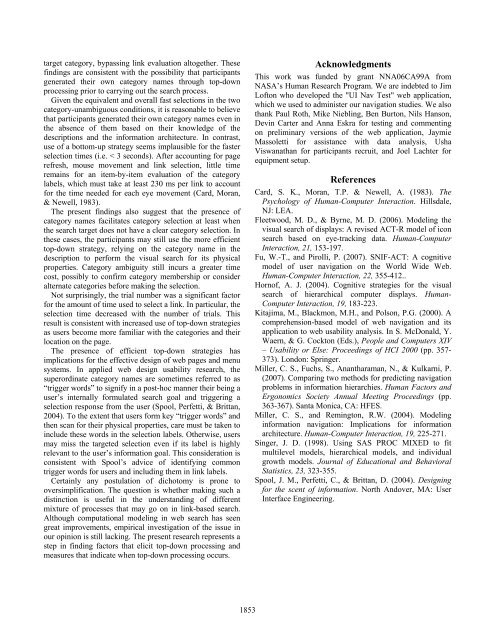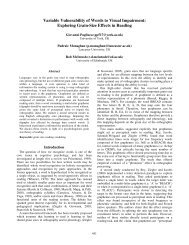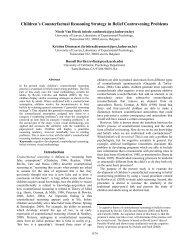Top-Down and Bottom-Up Processes in Web Search Navigation
Top-Down and Bottom-Up Processes in Web Search Navigation
Top-Down and Bottom-Up Processes in Web Search Navigation
You also want an ePaper? Increase the reach of your titles
YUMPU automatically turns print PDFs into web optimized ePapers that Google loves.
target category, bypass<strong>in</strong>g l<strong>in</strong>k evaluation altogether. These<br />
f<strong>in</strong>d<strong>in</strong>gs are consistent with the possibility that participants<br />
generated their own category names through top-down<br />
process<strong>in</strong>g prior to carry<strong>in</strong>g out the search process.<br />
Given the equivalent <strong>and</strong> overall fast selections <strong>in</strong> the two<br />
category-unambiguous conditions, it is reasonable to believe<br />
that participants generated their own category names even <strong>in</strong><br />
the absence of them based on their knowledge of the<br />
descriptions <strong>and</strong> the <strong>in</strong>formation architecture. In contrast,<br />
use of a bottom-up strategy seems implausible for the faster<br />
selection times (i.e. < 3 seconds). After account<strong>in</strong>g for page<br />
refresh, mouse movement <strong>and</strong> l<strong>in</strong>k selection, little time<br />
rema<strong>in</strong>s for an item-by-item evaluation of the category<br />
labels, which must take at least 230 ms per l<strong>in</strong>k to account<br />
for the time needed for each eye movement (Card, Moran,<br />
& Newell, 1983).<br />
The present f<strong>in</strong>d<strong>in</strong>gs also suggest that the presence of<br />
category names facilitates category selection at least when<br />
the search target does not have a clear category selection. In<br />
these cases, the participants may still use the more efficient<br />
top-down strategy, rely<strong>in</strong>g on the category name <strong>in</strong> the<br />
description to perform the visual search for its physical<br />
properties. Category ambiguity still <strong>in</strong>curs a greater time<br />
cost, possibly to confirm category membership or consider<br />
alternate categories before mak<strong>in</strong>g the selection.<br />
Not surpris<strong>in</strong>gly, the trial number was a significant factor<br />
for the amount of time used to select a l<strong>in</strong>k. In particular, the<br />
selection time decreased with the number of trials. This<br />
result is consistent with <strong>in</strong>creased use of top-down strategies<br />
as users become more familiar with the categories <strong>and</strong> their<br />
location on the page.<br />
The presence of efficient top-down strategies has<br />
implications for the effective design of web pages <strong>and</strong> menu<br />
systems. In applied web design usability research, the<br />
superord<strong>in</strong>ate category names are sometimes referred to as<br />
“trigger words” to signify <strong>in</strong> a post-hoc manner their be<strong>in</strong>g a<br />
user’s <strong>in</strong>ternally formulated search goal <strong>and</strong> trigger<strong>in</strong>g a<br />
selection response from the user (Spool, Perfetti, & Brittan,<br />
2004). To the extent that users form key “trigger words” <strong>and</strong><br />
then scan for their physical properties, care must be taken to<br />
<strong>in</strong>clude these words <strong>in</strong> the selection labels. Otherwise, users<br />
may miss the targeted selection even if its label is highly<br />
relevant to the user’s <strong>in</strong>formation goal. This consideration is<br />
consistent with Spool’s advice of identify<strong>in</strong>g common<br />
trigger words for users <strong>and</strong> <strong>in</strong>clud<strong>in</strong>g them <strong>in</strong> l<strong>in</strong>k labels.<br />
Certa<strong>in</strong>ly any postulation of dichotomy is prone to<br />
oversimplification. The question is whether mak<strong>in</strong>g such a<br />
dist<strong>in</strong>ction is useful <strong>in</strong> the underst<strong>and</strong><strong>in</strong>g of different<br />
mixture of processes that may go on <strong>in</strong> l<strong>in</strong>k-based search.<br />
Although computational model<strong>in</strong>g <strong>in</strong> web search has seen<br />
great improvements, empirical <strong>in</strong>vestigation of the issue <strong>in</strong><br />
our op<strong>in</strong>ion is still lack<strong>in</strong>g. The present research represents a<br />
step <strong>in</strong> f<strong>in</strong>d<strong>in</strong>g factors that elicit top-down process<strong>in</strong>g <strong>and</strong><br />
measures that <strong>in</strong>dicate when top-down process<strong>in</strong>g occurs.<br />
1853<br />
Acknowledgments<br />
This work was funded by grant NNA06CA99A from<br />
NASA’s Human Research Program. We are <strong>in</strong>debted to Jim<br />
Lofton who developed the "UI Nav Test" web application,<br />
which we used to adm<strong>in</strong>ister our navigation studies. We also<br />
thank Paul Roth, Mike Niebl<strong>in</strong>g, Ben Burton, Nils Hanson,<br />
Dev<strong>in</strong> Carter <strong>and</strong> Anna Eskra for test<strong>in</strong>g <strong>and</strong> comment<strong>in</strong>g<br />
on prelim<strong>in</strong>ary versions of the web application, Jaymie<br />
Massoletti for assistance with data analysis, Usha<br />
Viswanathan for participants recruit, <strong>and</strong> Joel Lachter for<br />
equipment setup.<br />
References<br />
Card, S. K., Moran, T.P. & Newell, A. (1983). The<br />
Psychology of Human-Computer Interaction. Hillsdale,<br />
NJ: LEA.<br />
Fleetwood, M. D., & Byrne, M. D. (2006). Model<strong>in</strong>g the<br />
visual search of displays: A revised ACT-R model of icon<br />
search based on eye-track<strong>in</strong>g data. Human-Computer<br />
Interaction, 21, 153-197.<br />
Fu, W.-T., <strong>and</strong> Pirolli, P. (2007). SNIF-ACT: A cognitive<br />
model of user navigation on the World Wide <strong>Web</strong>.<br />
Human-Computer Interaction, 22, 355-412..<br />
Hornof, A. J. (2004). Cognitive strategies for the visual<br />
search of hierarchical computer displays. Human-<br />
Computer Interaction, 19, 183-223.<br />
Kitajima, M., Blackmon, M.H., <strong>and</strong> Polson, P.G. (2000). A<br />
comprehension-based model of web navigation <strong>and</strong> its<br />
application to web usability analysis. In S. McDonald, Y.<br />
Waern, & G. Cockton (Eds.), People <strong>and</strong> Computers XIV<br />
– Usability or Else: Proceed<strong>in</strong>gs of HCI 2000 (pp. 357-<br />
373). London: Spr<strong>in</strong>ger.<br />
Miller, C. S., Fuchs, S., Anantharaman, N., & Kulkarni, P.<br />
(2007). Compar<strong>in</strong>g two methods for predict<strong>in</strong>g navigation<br />
problems <strong>in</strong> <strong>in</strong>formation hierarchies. Human Factors <strong>and</strong><br />
Ergonomics Society Annual Meet<strong>in</strong>g Proceed<strong>in</strong>gs (pp.<br />
363-367). Santa Monica, CA: HFES.<br />
Miller, C. S., <strong>and</strong> Rem<strong>in</strong>gton, R.W. (2004). Model<strong>in</strong>g<br />
<strong>in</strong>formation navigation: Implications for <strong>in</strong>formation<br />
architecture. Human-Computer Interaction, 19, 225-271.<br />
S<strong>in</strong>ger, J. D. (1998). Us<strong>in</strong>g SAS PROC MIXED to fit<br />
multilevel models, hierarchical models, <strong>and</strong> <strong>in</strong>dividual<br />
growth models. Journal of Educational <strong>and</strong> Behavioral<br />
Statistics, 23, 323-355.<br />
Spool, J. M., Perfetti, C., & Brittan, D. (2004). Design<strong>in</strong>g<br />
for the scent of <strong>in</strong>formation. North Andover, MA: User<br />
Interface Eng<strong>in</strong>eer<strong>in</strong>g.





